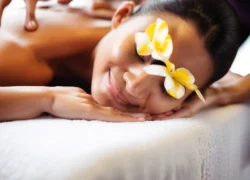Have you ever felt so stressed or stiff that it’s hard to move? I’ve been there too. That’s when I discovered Thai massage. It’s not just a massage—it’s an experience. Thai massage is different from anything else, and if you’ve never tried it, you’re missing out. Let me take you through everything you need to know about Thai massage.
What is Thai massage?
Thai massage is a traditional therapy from Thailand. It’s been around for over 2,500 years! What makes it special? Unlike other massages, Thai massage involves stretching and pressure. It’s like yoga, but someone else does the work for you.
I’ve tried other massages, but Thai massage feels unique. It doesn’t use oils or lotions like a Swedish massage. Instead, you stay fully clothed. The therapist uses their hands, elbows, knees, and even feet to work on your body. It’s an active process, and you’ll leave feeling refreshed.
Benefits of Thai Massage
Have you ever wondered if a massage can do more than just relax you? Thai massage can. It helps improve flexibility, reduces stress, and increases energy.
When I first tried it, I felt stiff from sitting at a desk all day. After just one session, my body felt lighter. Thai massage focuses on energy lines in your body, which helps you feel balanced.
Some people say it helps with back pain, headaches, and even insomnia. I’ve noticed that it helps me sleep better. If you’ve ever felt too tense to relax, a Thai massage might be what you need.
What to Expect During a Session
If you have never been to a Thai massage, you may feel a little apprehensive. Don’t worry. The first time I went, I didn’t know what to expect either. Here’s what usually happens:
- You will be fully clothed at all times. Loose, comfortable clothing is best.
- The therapist might ask you about your areas of concern.
- You’ll lie on a mat, not a table. This gives them room to move you around.
The therapist will be using their hands and body to stretch and press your muscles. Sometimes, they will guide your body into yoga-like poses. It may feel intense at first, but it is never painful. If it is your first time, let them know. They’ll adjust the pressure to make sure you’re comfortable.
Who Can Benefit from Thai Massage?
I feel that anyone can benefit from Thai massage. Are you stressed? Have you got tight muscles? Maybe you want to increase your flexibility. Thai massage can help. It’s great for athletes, office workers, or anyone who feels tired or tense.
I’ve even heard that some pregnant women use Thai massage to relieve pain. Of course, you should always talk to your doctor first. But it shows how versatile this massage is. If you’re curious, I’d say give it a try.
How Often Should You Get a Thai Massage?
You might wonder how often you should go. That depends on your needs. When I started, I went once a month. It was enough to keep me feeling good. If you’re dealing with a lot of stress or pain, you might want to go more often—maybe every week. Listen to your body. You’ll know when it’s time for another session.
Tips for Your First Thai Massage
If it’s your first time, here are a few tips:
- Wear loose, comfortable clothes.
- Drink water before and after your session.
- Communicate with your therapist. Let them know if the pressure feels too much or too little.
- Relax. It’s normal to feel a little sore afterward, but it’s a good kind of sore.
I’ll be honest: I felt a little awkward the first time. But the therapist was kind and made me feel comfortable. By the end, I was so relaxed that I didn’t want to leave.
Why Choose Thai Massage Over Other Types?
You might ask, Why not stick to regular massages? I’ve tried them too, but Thai massage stands out. It’s not just about relaxation. It’s about healing your body and mind. The stretching helps your muscles, while the pressure improves blood flow. It’s like getting a workout and a massage at the same time.
Thai massage is also rooted in tradition. It connects you to a practice that’s been around for centuries. If you appreciate something with history and meaning, you’ll love it.
Final Thoughts on Thai Massage
If you’ve never tried Thai massage, I can’t recommend it enough. It’s not just a treat—it’s an investment in your health. Whether you’re looking to relax, relieve pain, or improve flexibility, Thai massage can help. It’s an experience you won’t forget.
Ready to try it? If you’re near Wake Forest, NC, check out Raleigh Massage. They’ll take great care of you.







